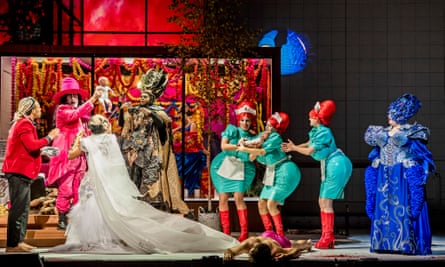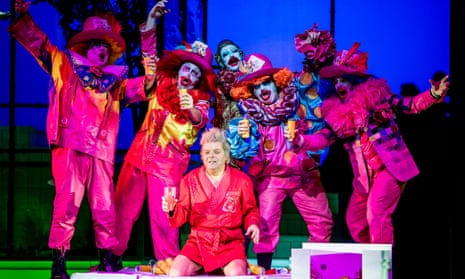When English National Opera presented the premiere of The Mask of Orpheus at the Coliseum in 1986, I doubt many of us in the audience thought we would have to wait 33 years to see it on stage again. In the meantime both in the UK and elsewhere in Europe, other productions of what was acknowledged as the defining work of Harrison Birtwistle’s early career and a landmark in 20th-century British opera, had regularly been promised, only for plans to be abandoned sooner or later, because of the sheer financial and technical challenges of realising them.
But now this monumental work is back at the Coliseum, the centrepiece of ENO’s Orpheus season. For that, at least, much thanks. Those who were not around to experience the work in 1986, or the concert staging performance at the Royal Festival Hall 10 years later, will need to catch this version, if only to experience the magnificence of much of the music, which is an immense achievement for conductor Martyn Brabbins and everyone else involved. But those who have fond memories of the original production, might be advised to stay away from what in most other respects is a travesty of what Birtwistle and his librettist Peter Zinovieff envisaged, and of what the work represents.

The production is the work of ENO’s departing artistic director Daniel Kramer, and let’s hope it is the last of his shows to be seen there. For this is a wilful parade of self-indulgence, with set designs by Lizzie Clachan translating the action to a sleek modern apartment, and costumes by Daniel Lismore that might be more appropriate in a Rio carnival procession or on the Mexican Day of the Dead. It’s a gaudy display, which does nothing to tease out the complexities of a work that presents the Orpheus story as a bundle of contradictory myths where events are repeated and linear time abandoned, and in which the three main protagonists, Orpheus, Euridice and Aristaeus, are each represented on stage by two singers and a mime, representing the person, the myth and the hero. Instead, Kramer simply adds business of his own, cluttering the stage with irrelevancies. Rather than austere, penetrating ritual, all we get is camp and bling, combined with an apparent insistence on adding comedy to the action, so that the judges of the dead and the furies become a troupe of vaudeville caricatures.
At least Brabbins and the second conductor James Henshaw clearly know what they are doing. The immense, writhing power of Birtwistle’s orchestral writing, and the sheer originality and beauty of the electronic interludes that he and composer Barry Anderson realised at IRCAM in Paris, emerge with startling, abrasive clarity. It’s all been meticulously prepared, and if Peter Hoare in the main role of Orpheus the Man can’t make his character as compelling as Philip Langridge did in the original production, it’s still an immense, tireless performance. He sets the standard for the rest of the cast, including Daniel Norman as Orpheus the Myth, Marta Fontanals-Simmons as Euridice the Woman, James Cleverton as Aristaeus the Man, and Claron McFadden as the Oracle of the Dead.
None of them disappoint, yet such musical excellence seems to be a low priority for the current ENO regime. Half the press release for the first night was devoted to the company that supplied the glass crystals adorning many of the costumes, and which apparently “star” in the production, while two models wearing Lismore’s designs paraded through the foyer before the performance. Is this the kind of thing that matters most at the Coliseum now?

Comments (…)
Sign in or create your Guardian account to join the discussion